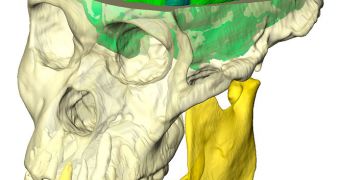Investigators at the Indiana University announce the creation of a new computer model depicting the brain of Australopithecus sediba, an ancient hominin species that lived around 2 million years ago.
The creature did not necessarily have a bigger brain than its predecessors, but it was a much better, more efficient brain, the team determined from the simulations. Experts developed the model in order to fill the hollow surfaces of the hominin's skull.
Indiana Department of Anthropology research associate Kristian Carlson was the leader of the new investigation, which also included six other experts. The fossils on which the study was carried out were discovered around 18 months ago in South Africa.
A detailed account of the research is published in the September 8 issue of the top journal Science. Carlson is the lead author of one of five papers covering the subject of A. sediba. The other four deal with describing the creature's skeleton, pelvis, hand, and foot and ankle.
Though she conducted the investigation as part of an Indiana team, Carlson is now based at the University of Witwatersrand Institute for Human Evolution, in South Africa. He explains that the new data cover a confusing period in human evolution, that thus far left experts puzzled.
This research therefore covered holes in our knowledge about the evolution of our distant ancestors. The time when A. sediba evolved is widely considered to be one of the most important periods of human evolution, both in terms of body and brain.
“The period of evolutionary history that these fossils represent (1.977 million years ago) is approximately the period during which our genus, Homo, may have emerged,” Carlson explains.
“And this is one of the most exceptionally well-preserved endocasts associated with early hominin cranial and post cranial remains,” the expert goes on to say. The fossil recovered from South Africa has been named MH1, and is a juvenile male.
The most important thing the model revealed was a noticeable expansion in an area of the brain called the prefrontal cortex. This region is known for its role in underlying complex tasks such as multi-tasking, innovation and reasoning in modern humans.
“So these results are consistent with the gradual neural reorganization of the orbitofrontal region in the transition from Australopithecus to Homo. But, given the small volume of the MH1 endocast, the results are not consistent with gradual brain enlargement before the transition to Homo,” Carlson concludes.

 14 DAY TRIAL //
14 DAY TRIAL //